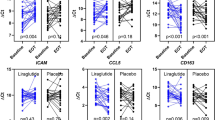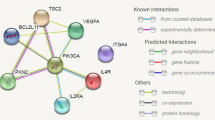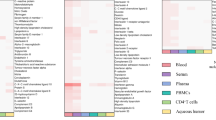Abstract
Aim:
Peroxisome proliferator-activated receptor-γ (PPAR-γ) has a wide range of biological functions, including anti-inflammation. In this study, we investigated the inhibitory effects of PPAR-γ on transforming growth factor β1 (TGF-β1)-induced interleukin-8 (IL-8) and monocyte chemoattractant protein-1 (MCP-1) expression in renal tubular epithelial cells (HK-2).
Methods:
HK-2 cells were pretreated with 15d-PGJ2 or troglitazone (TGL) and then treated with TGF-β1. Expression of MCP-1 and IL-8 was measured using real-time PCR and ELISA.
Results:
Treatment with 5 ng/mL TGF-β1 for 24 h increased both MCP-1 and IL-8 mRNA and protein levels in HK-2 cells. Both 15d-PGJ2 at 2.5 and 5 μmol/L and TGL at 2.5 μmol/L exhibited inhibitory effects on TGF-β1-induced MCP-1 expression. Additionally, 15d-PGJ2 at 2.5 and 5 μmol/L and TGL at 2.5 μmol/L inhibited TGF-β1-induced expression of IL-8.
Conclusion:
PPAR-γ agonists (15d-PGJ2 and TGL) could inhibit the TGF-β1-induced expression of chemokines in HK-2 cells. Our results suggest that PPAR-γ agonists have the potential to be used as a treatment regimen to reduce inflammation in renal tubulointerstitial disease.
Similar content being viewed by others
Log in or create a free account to read this content
Gain free access to this article, as well as selected content from this journal and more on nature.com
or
References
Remuzzi G, Bertani T . Pathophysiology of progressive nephropathies. N Engl J Med 1998; 339: 1448–56.
Bohle A, Muller GA, Wehrmann M, Mackensen-Haen S, Xiao JC . Pathogenesis of chronic renal failure in the primary glomerulopathies, renal vasculopathies, and chronic interstitial nephritides. Kidney Int 1996; Suppl 54: S2–9.
Nath KA . Tubulointerstitial changes as a major determinant in the progression of renal damage. Am J Kidney Dis 1992; 20: 1–17.
Wang W, Koka V, Lan HY . Transforming growth factor-beta and Smad signalling in kidney diseases. Nephrology (Carlton) 2005; 10: 48–56.
Liu Y . Renal fibrosis: new insights into the pathogenesis and therapeutics. Kidney Int 2006; 69: 213–7.
Wolf G . Renal injury due to renin-angiotensin-aldosterone system activation of the transforming growth factor-beta pathway. Kidney Int 2006; 70: 1914–9.
Panzer U, Steinmetz OM, Stahl RA, Wolf G . Kidney diseases and chemokines. Curr Drug Targets 2006; 7: 65–80.
Guan Y, Breyer MD . Peroxisome proliferator-activated receptors (PPARs): novel therapeutic targets in renal disease. Kidney Int 2001; 60: 14–30.
Eun CS, Han DS, Lee SH, Paik CH, Chung YW, Lee J, et al. Attenuation of colonic inflammation by PPARgamma in intestinal epithelial cells: effect on Toll-like receptor pathway. Dig Dis Sci 2006; 51: 693–7.
Wang WM, Liu F, Chen N . The effects of peroxisome proliferators-activated receptor γ agonists on TGF-β1-Smads signal pathway in rat renal fibroblasts. Natl Med J China 2006; 86: 740–4.
Liu F, Wang WM, Chen N . The effects of peroxisome proliferators-activated receptor γ agonists on TGF-β1-induced extracellular matrix expression in renal fibroblasts . J Nephrol Dialy Transplant 2006; 15: 30–4.
Ruan XZ, Varghese Z, Powis SH, Moorhead JF . Nuclear receptors and their coregulators in kidney. Kidney Int 2005; 68: 2444–61.
Lu B, Moser AH, Shigenaga JK, Feingold KR, Grunfeld C . Type II nuclear hormone receptors, coactivator, and target gene repression in adipose tissue in the acute-phase response. J Lipid Res 2006; 47: 2179–90.
Glass CK, Ogawa S . Combinatorial roles of nuclear receptors in inflammation and immunity. Nat Rev Immunol 2006; 6: 44–55.
Tien ES, Hannon DB, Thompson JT, Vanden Heuvel JP . Examination of ligand-dependent coactivator recruitment by peroxisome proliferator-activated receptor-alpha (PPARalpha). PPAR Res 2006; 2006: 69612–20.
Han SJ, Jung SY, Malovannaya A, Kim T, Lanz RB, Qin J, et al. A scoring system for the follow up study of nuclear receptor coactivator complexes. Nucl Recept Signal 2006; 4: e014.
Segerer S, Nelson PJ, Schlondorff D . Chemokines, chemokine receptors, and renal disease: from basic science to pathophysiologic and therapeutic studies. J Am Soc Nephrol 2000; 11: 152–76.
Daha MR, van Kooten C . Is the proximal tubular cell a proinflammatory cell? Nephrol Dial Transplant 2000; 15 Suppl 6: 41–3.
Wang SN, LaPage J, Hirschberg R . Role of glomerular ultrafiltration of growth factors in progressive interstitial fibrosis in diabetic nephropathy. Kidney Int 2000; 57: 1002–14.
Tesch GH, Schwarting A, Kinoshita K, Lan HY, Rollins BJ, Kelley VR . Monocyte chemoattractant protein-1 promotes macrophage-mediated tubular injury, but not glomerular injury, in nephrotoxic serum nephritis. J Clin Invest 1999; 103: 73–80.
Viedt C, Orth SR . Monocyte chemoattractant protein-1 (MCP-1) in the kidney: does it more than simply attract monocytes? Nephrol Dial Transplant 2002; 17: 2043–7.
Grandaliano G, Gesualdo L, Ranieri E, Monno R, Montinaro V, Marra F, et al. Monocyte chemotactic peptide-1 expression in acute and chronic human nephritides: a pathogenetic role in interstitial monocytes recruitment. J Am Soc Nephrol 1996; 7: 906–13.
Gerritsma JS, Hiemstra PS, Gerritsen AF, Prodjosudjadi W, Verweij CL, Van Es LA, et al. Regulation and production of IL-8 by human proximal tubular epithelial cells in vitro. Clin Exp Immunol 1996; 103: 289–94.
Qi W, Chen X, Polhill TS, Sumual S, Twigg S, Gilbert RE, et al. TGF-beta1 induces IL-8 and MCP-1 through a connective tissue growth factor-independent pathway. Am J Physiol Renal Physiol 2006; 290: F703–709.
Wang W, Liu F, Chen N . Peroxisome proliferator-activated receptor-gamma (PPAR-gamma) agonists attenuate the profibrotic response induced by TGF-beta1 in renal interstitial fibroblasts. Mediators Inflamm 2007; 2007: 62641–7.
Deckers JG, Va Der Woude FJ, Van Der Kooij SW, Daha MR . Synergistic effect of IL-1alpha, IFN-gamma, and TNF-alpha on RANTES production by human renal tubular epithelial cells in vitro. J Am Soc Nephrol 1998; 9: 194–202.
Wang SN, Lapage J, Hirschberg R . Glomerular ultrafiltration and apical tubular action of IGF-I, TGF-beta, and HGF in nephrotic syndrome. Kidney Int 1999; 56: 1247–51.
Lehrke M, Lazar MA . The many faces of PPARgamma. Cell 2005; 123: 993–9.
Cabrero A, Laguna JC, Vazquez M . Peroxisome proliferator-activated receptors and the control of inflammation. Curr Drug Targets Inflamm Allergy 2002; 1: 243–8.
Dubuquoy L, Rousseaux C, Thuru X, Peyrin-Biroulet L, Romano O, Chavatte P, et al. PPARgamma as a new therapeutic target in inflammatory bowel diseases. Gut 2006; 55: 1341–9.
Fu Y, Luo N, Lopes-Virella MF . Upregulation of interleukin-8 expression by prostaglandin D2 metabolite 15-deoxy-delta12, 14 prostaglandin J2 (15d-PGJ2) in human THP-1 macrophages. Atherosclerosis 2002; 160: 11–20.
Chung BH, Lim SW, Ahn KO, Sugawara A, Ito S, Choi BS, et al. Protective effect of peroxisome proliferator activated receptor gamma agonists on diabetic and non-diabetic renal diseases. Nephrology (Carlton) 2005; 10 Suppl: S40–3.
Xiong Z, Huang H, Li J, Guan Y, Wang H . Anti-inflammatory effect of PPARgamma in cultured human mesangial cells. Ren Fail 2004; 26: 497–505.
Li H, Ruan XZ, Powis SH, Fernando R, Mon WY, Wheeler DC, et al. EPA and DHA reduce LPS-induced inflammation responses in HK-2 cells: evidence for a PPAR-gamma-dependent mechanism. Kidney Int 2005; 67: 867–74.
Zafiriou S, Stanners SR, Polhill TS, Poronnik P, Pollock CA . Pioglitazone increases renal tubular cell albumin uptake but limits proinflammatory and fibrotic responses. Kidney Int 2004; 65: 1647–53.
Acknowledgements
This work was supported by grants from the National Natural Science Foundation of China (30270613 and 30771000), the Leading Academic Discipline Project of Shanghai Health Bureau (05III001 and 2003ZD002) and the Shanghai Leading Academic Discipline Project (T0201), China.
Author information
Authors and Affiliations
Corresponding author
Rights and permissions
About this article
Cite this article
Wang, Wm., Zhang, Hd., Jin, Ym. et al. PPAR-γ agonists inhibit TGF-β1-induced chemokine expression in human tubular epithelial cells. Acta Pharmacol Sin 30, 107–112 (2009). https://doi.org/10.1038/aps.2008.15
Received:
Accepted:
Published:
Issue date:
DOI: https://doi.org/10.1038/aps.2008.15



